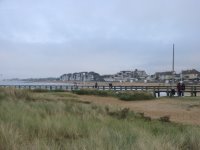This was quite a moving experience as we drove the coast of
We started at
The Juno Beach Centre was opened in 2003 and is staffed by Canadian student interns on four-month assignments. The exhibits trace Canadian involvement in World War 2 and in the D-Day invasion. We walked out of the museum onto the beach through a steel passageway
built in the size and shape of the D-Day landing craft. We passed old German gun emplacements half sunk into the sand and the tracks of
the tunnels that joined them. Click on the photos below for larger views.


 Wanting a place to build the new harbour, they did not invade the beach at Arromanches as part of the initial invasion. Instead, they captured the area by land later on the day of June 6 and by the next day they had begun the construction of the port and had begun landing ships. It is an incredible achievement of engineering.
Wanting a place to build the new harbour, they did not invade the beach at Arromanches as part of the initial invasion. Instead, they captured the area by land later on the day of June 6 and by the next day they had begun the construction of the port and had begun landing ships. It is an incredible achievement of engineering. Further along the coast at Longues-sur-mer we came across German heavy cannons still sitting in their concrete bunkers on the cliffs, pointing out across the channel. Although they were mostly intact, you could still see where one had been blown apart by incoming fire. The open fields and the small villages with their church spires gave us very vivid images of how it must have felt for the soldiers on those days to face the risks and fears as they moved across the countryside.
Although they were mostly intact, you could still see where one had been blown apart by incoming fire. The open fields and the small villages with their church spires gave us very vivid images of how it must have felt for the soldiers on those days to face the risks and fears as they moved across the countryside.
Here is a short film clip on the landings that day from the History Channel web site.
We made the turn back towards our B and B at  Very picturesque narrow streets lead to the impressive cathedral that dates from the 11th century.
Very picturesque narrow streets lead to the impressive cathedral that dates from the 11th century.
A long day followed by a Sunday dinner in an old auberge, but more about that later.











1 Comments:
BonJour Everyone:
Was very interested in this blog - Bryan and I have decided this is one place we will not miss visiting when we come over. If I had know you were going to Juno Beach I would have told you to look for bricks for Dad, Uncle Ab and Uncle Ralph in the Centre. Looking forward to more!!
P.S. Brian, you look wonderful - how did you lose your weight?
Luv to all......Lynne
Post a Comment
<< Home